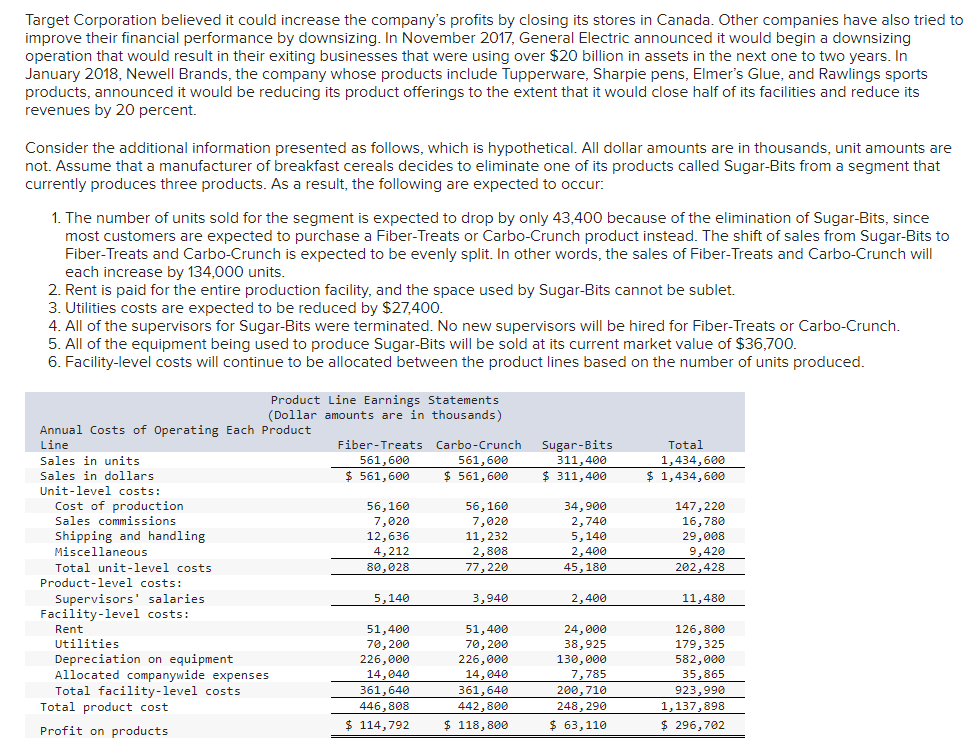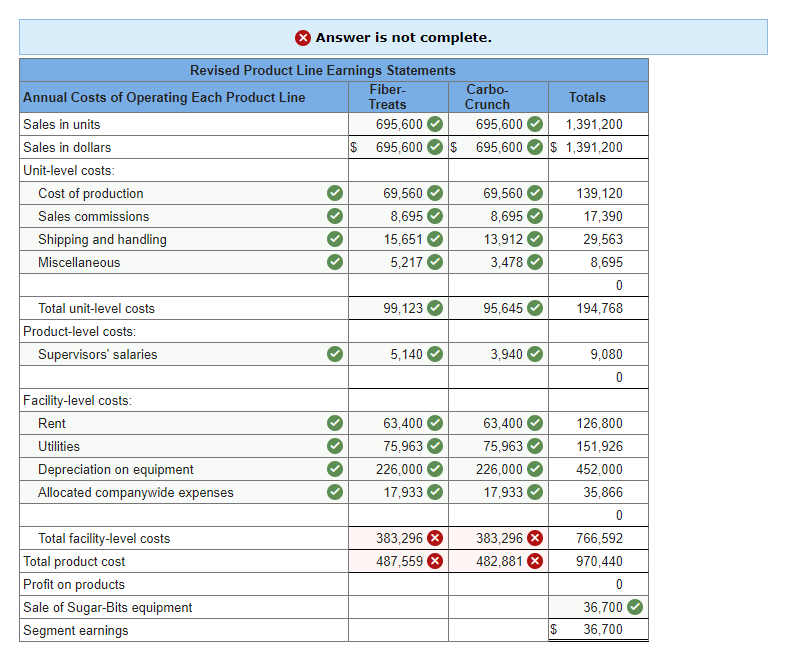Target Corporation believed it could increase the company's profits by closing its stores in Canada. Other companies have also tried to improve their financial performance by downsizing. In November 2017, General Electric announced it would begin a downsizing operation that would result in their exiting businesses that were using over $20 billion in assets in the next one to two years. In January 2018, Newell Brands, the company whose products include Tupperware, Sharpie pens, Elmer's Glue, and Rawlings sports products, announced it would be reducing its product offerings to the extent that it would close half of its facilities and reduce its revenues by 20 percent. Consider the additional information presented as follows, which is hypothetical. All dollar amounts are in thousands, unit amounts are not. Assume that a manufacturer of breakfast cereals decides to eliminate one of its products called Sugar-Bits from a segment that currently produces three products. As a result, the following are expected to occur: 1. The number of units sold for the segment is expected to drop by only 43,400 because of the elimination of Sugar-Bits, since most customers are expected to purchase a Fiber-Treats or Carbo-Crunch product instead. The shift of sales from Sugar-Bits to Fiber-Treats and Carbo-Crunch is expected to be evenly split. In other words, the sales of Fiber-Treats and Carbo-Crunch will each increase by 134,000 units. 2. Rent is paid for the entire production facility, and the space used by Sugar-Bits cannot be sublet. 3. Utilities costs are expected to be reduced by $27,400. 4. All of the supervisors for Sugar-Bits were terminated. No new supervisors will be hired for Fiber-Treats or Carbo-Crunch. 5. All of the equipment being used to produce Sugar-Bits will be sold at its current market value of $36,700. 6. Facility-level costs will continue to be allocated between the product lines based on the number of units produced. Annual Costs of Operating Each Product Line Sales in units Sales in dollars Unit-level costs: Cost of production Sales commissions Shipping and handling Miscellaneous Total unit-level costs Product-level costs: Supervisors' salaries. Facility-level costs: Rent Product Line Earnings Statements (Dollar amounts are in thousands) Utilities Depreciation on equipment Allocated companywide expenses Total facility-level costs Total product cost Profit on products Fiber-Treats Carbo-Crunch 561,600 561,600 $ 561,600 $ 561,600 56,160 7,020 12,636 4,212 80,028 5,140 51,400 70,200 226,000 14,040 361,640 446,808 $ 114,792 56,160 7,020 11, 232 2,808 77,220 3,940 51,400 70, 200 226,000 14,040 361,640 442,800 $ 118,800 Sugar-Bits 311,400 $ 311,400 34,900 2,740 5,140 2,400 45,180 2,400 24,000 38,925 130,000 7,785 200,710 248,290 $ 63,110 Total 1,434,600 $ 1,434,600 147,220 16,780 29,008 9,420 202,428 11,480 126,800 179,325 582,000 35,865 923,990 1,137,898 $ 296,702
Target Corporation believed it could increase the company’s profits by closing its stores in Canada. Other companies have also tried to improve their financial performance by downsizing. In November 2017, General Electric announced it would begin a downsizing operation that would result in their exiting businesses that were using over $20 billion in assets in the next one to two years. In January 2018, Newell Brands, the company whose products include Tupperware, Sharpie pens, Elmer’s Glue, and Rawlings sports products, announced it would be reducing its product offerings to the extent that it would close half of its facilities and reduce its revenues by 20 percent.
Consider the additional information presented as follows, which is hypothetical. All dollar amounts are in thousands, unit amounts are not. Assume that a manufacturer of breakfast cereals decides to eliminate one of its products called Sugar-Bits from a segment that currently produces three products. As a result, the following are expected to occur:
-
The number of units sold for the segment is expected to drop by only 43,400 because of the elimination of Sugar-Bits, since most customers are expected to purchase a Fiber-Treats or Carbo-Crunch product instead. The shift of sales from Sugar-Bits to Fiber-Treats and Carbo-Crunch is expected to be evenly split. In other words, the sales of Fiber-Treats and Carbo-Crunch will each increase by 134,000 units.
-
Rent is paid for the entire production facility, and the space used by Sugar-Bits cannot be sublet.
-
Utilities costs are expected to be reduced by $27,400.
-
All of the supervisors for Sugar-Bits were terminated. No new supervisors will be hired for Fiber-Treats or Carbo-Crunch.
-
All of the equipment being used to produce Sugar-Bits will be sold at its current market value of $36,700.
-
Facility-level costs will continue to be allocated between the product lines based on the number of units produced.
I am unable to get the total facility-level costs to add up properly. I'm not sure why as there are no other line items that should be required. Because this isn't adding up, the rest will be wrong as well.


Trending now
This is a popular solution!
Step by step
Solved in 3 steps






